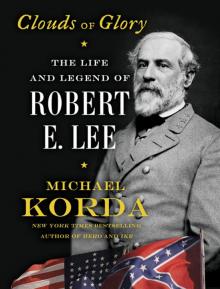- Home
- Michael Korda
Clouds of Glory Page 39
Clouds of Glory Read online
Page 39
During much of this time Stonewall Jackson was maneuvering his small force in the Shenandoah Valley. At first it consisted of no more than the 5,000 men of the “Stonewall Brigade,” which he had led at First Manassas, reinforced by a few militia units. Jackson’s headquarters were at Winchester, and he came under the nominal command of General Joseph E. Johnston. Jackson had, along with his other military virtues, a certain gift for what we would now call guerrilla warfare, in the style of T. E. Lawrence, and understood the value of tearing up enemy railway lines and destroying railway bridges. Jackson’s cavalry ranged far enough north to harass the Baltimore and Ohio railroad, and interrupt traffic on the Chesapeake and Ohio Canal, while he himself fought small actions at Hancock, Maryland; and Bath, Virginia. These were more in the nature of nuisance attacks than for any major strategic purpose, his mission being to prevent the Union’s Major General Nathaniel P. Banks, with much larger forces centered on Harpers Ferry, from ascending up the Valley toward Strasburg and Staunton and threatening the vital railway lines linking Richmond with the west. The sudden arrival of Jackson’s forces in places where they were unexpected—and the indignation of pro-Union residents at being subjected, however briefly, to Confederate occupation—kept Banks’s attention (as well as Lincoln’s) fixed on Jackson, who seemed able to appear and disappear at will. This has been attributed to the fact that he was a local boy and knew the countryside, but in truth Jackson simply had the good sense to ask local secessionists to sort out the tangled back roads and twisty creeks of the Valley for him. He also put to work a supremely gifted topographer and mapmaker, Captain Jedediah Hotchkiss, a native of New York who had settled in the South and whose maps are works of art, some of them sketched in the saddle with a pad and colored crayons. The map he made of the Valley at Jackson’s request would eventually consist of three pieces of “linen tracing paper,” glued together and nearly nine by four feet when unfolded.
Lee’s interest in Jackson was in part a reflection of an underlying difference of opinion between Lee, as President Davis’s military adviser, and Joseph E. Johnston, field commander of the Confederate forces in northern Virginia. Lee was studiously careful not to second-guess Johnston, who was prickly about any kind of interference; but, conscious of how slender the resources of the Confederate Army were and how inferior in numbers it was to the Union Army, Lee had grave doubts about Johnston’s wish to concentrate all of the Confederacy’s forces for one decisive battle to defeat McClellan before Richmond. Lee believed in the importance of concentration of forces as much as Johnston did, but he understood that there were advantages to keeping McClellan off balance with smaller attacks elsewhere that would delay or prevent him from achieving an overwhelming concentration of Union forces against Richmond. In any case the Confederacy could not afford the risk of losing a major battle at the gates of its own capital. Lee feared that Johnston was, in other words, prepared to play all or nothing, while he himself was not.
This was not really caution on Lee’s part, as many historians have suggested, so much as ordinary common sense. Lee’s objective was to keep the approaches to Richmond covered until such time as it was clear from which direction McClellan attacked, even if it meant the dispersal of Confederate forces in relatively small numbers at key points—exactly what Johnston most wanted to avoid. Although Confederate knowledge of the size of the Army of the Potomac was reliable enough—it was estimated at 155,000 men, almost three times the number of all Confederate troops in Virginia, plus at least 45,000 “garrison troops” to defend Washington—intelligence about the direction in which McClellan would attack was merely conjectural. It did not occur to Lee (nor to Davis or Johnston) that McClellan himself, like Hamlet, would be unable to decide; still less could Lee have guessed that McClellan supposed the Confederate forces facing him consisted of at least 200,000 men.
What Lee devised in his thankless role as the military éminence grise of President Davis was a daring strategic solution to the problem of McClellan’s inevitable attack on Richmond. He did this without any authority to give orders and with almost no friction between himself and the other senior Confederate generals. He saw at once that allowing Johnston to put all the Confederacy’s eggs in one basket on the Rappahannock would be fatal. McClellan could march south on Culpeper; cut the Virginia Central Railroad, at the same time flanking Johnston; then turn east at Gordonsville and march on Richmond. Or he could march south on Fredericksburg and attack Richmond from the north, the shortest route. Or he could make use of the Union’s overwhelming resources in shipping and move his army down the Potomac, landing it on the peninsula, close to Fort Monroe, only thirty-five miles from Richmond. Or—the worst case scenario for the Confederacy—he could order Banks (and later McDowell) to march on Fredericksburg from the west and simultaneously land on the peninsula himself, thus applying force on both sides of Richmond, like a nutcracker. Less probable, but still possible, McClellan could land his army at Norfolk and at Hampton Roads, advancing toward Richmond up both sides of the James River.
While keeping in mind Frederick the Great’s dictum, “He who attempts to defend everything, defends nothing,” Lee ensured that the key points on a rough semicircle drawn around Richmond were sufficiently well manned to slow down any enemy advance for long enough to carry out the concentration of Confederate forces in the right place. Timing would of course be a crucial factor, but with proper planning Lee would have the advantage of interior lines, and he understood the importance the railways would play in the defense of Richmond. He placed 3,000 men under Brigadier General Edward Johnson near McDowell (about twenty miles from Staunton and the Virginia Central Railroad) in case Major General John C. Frémont advanced through the Alleghenies to threaten Johnston’s left. At the same time he placed Jackson at Winchester to discourage General Banks from advancing up the Valley, while the main part of Johnston’s force, 40,000 men, remained at Centreville, behind stout earthworks and what McClellan assumed were substantial quantities of guns dug in. Closer to Richmond, Lee had Major General Theophilus Holmes at Fredericksburg with 6,000 men, Major General John B. Magruder with 3,000 men manning the line that crossed the peninsula, and Major General Benjamin Huger holding Norfolk and the vital navy yard with 9,000 men.
5. The Shenandoah Valley.
{Robert E. Lee, Volumes 1, 2, and 3, by Douglas Southall Freeman, copyright © 1934, 1935, by Charles Scribner’s Sons, copyright renewed 1962, 1963, by Inez Godden Freeman. All rights reserved.}
Lee quietly resisted Johnston’s desire to add some if not all of these troops to his force of 40,000, and set about the task of reinforcing Jackson in the Valley, first of all because he had absolute confidence in Jackson’s tactical skill and fighting spirit, and second because the Valley was the ideal place for a force as small as Jackson’s to tie up the 23,000 men of Banks’s army, and discourage any thought in Washington of moving those men toward the Rappahannock to support McClellan. He understood at once what seemed to be a mystery to everybody else except Jackson: the Valley contained one of the finest macadamized roads in the country, the famed Valley Pike, a commercial enterprise begun in 1834 and completed in 1841, which ran down the middle of the Valley and by the outbreak of the Civil War connected Staunton to Winchester, a distance of ninety-four miles. To the west there were five gaps in the Alleghenies, known as “river gaps” because they dropped to the floor of the Valley. To the east in the Blue Ridge Mountains, there were at least seven “wind gaps,” so called because they were merely depressions in the skyline. If one thinks of the Valley Pike as the spine of a fish skeleton, and the river gaps and wind gaps as its ribs, one can understand how Jackson, once Hotchkiss had drawn the map, could move his troops through one of the gaps, reach the Valley Pike, and once on it advance them at an astonishing speed. They could attack, then move through another of the gaps to regroup and attack somewhere else within a few days. Jackson had been born and bred in what is now West Virginia, so the landscape was familiar to him, and Hotchkiss’s map
of the Valley enabled him to take full advantage of it. Even Mary Chesnut, the diarist, remarked that she slept more securely “with the serenest faith that Jackson is to flank everybody and never to be flanked himself,” a faith that Lee shared.
What is so striking about the Civil War is the rapid pace of events. We are used to thinking of the past as more leisurely, as of course it was in terms of transportation and communication by our standards, but considering the distances involved, the pressure and pace of events must have seemed dizzying, all the more so because of the new effect of railways and the telegraph on war.
Lee returned to Richmond in the first week of March 1862, only to discover that on March 9 Johnston had abandoned his line on Centreville and withdrawn his army twenty-five miles farther south to the Rappahannock, with his center at Culpeper Court House. Johnston abandoned many of his stores, revealing that many of the batteries that had aroused McClellan’s fears were armed with “Quaker guns,” logs painted black to give the impression of a mass of artillery.
On March 14 Lee paused long enough to write to Mary, suggesting that she might want to consider moving from White House, on the Pamunkey River, which was outside Magruder’s lines and right in the path of any Union advance up the peninsula, to Richmond (advice which as usual she did not take). This suggests that Lee was already outthinking Johnston, and possibly even McClellan.
On March 23, having marched his troops forty miles in two days, Jackson attacked the Union forces of Brigadier General James Shields at Kernstown, and suffered his only defeat (though it was a strategic victory for Lee, since it kept the Union forces bottled up in the Valley). The next day General Magruder reported that startling news that 35,000 Union troops had been landed from steamers at Old Point, sheltered by Fort Monroe, raising the possibility of a Federal advance up the peninsula on Richmond. Among his other attributes, Lee had nerves of steel: momentous events and bad news at short intervals never shook him, he remained calm, calmed others, and searched for a solution. Now, Lee cannily responded by moving small units of troops toward the peninsula and sought everywhere for weapons with which to arm them, including ancient smoothbore flintlocks. He was even forced to set in motion, as an emergency measure, the manufacture of pikes like those John Brown had taken to Harpers Ferry.
Everywhere he looked, from the Mississippi to the peninsula, he was besieged by pleas from governors and from generals for troops, weapons, and ammunition, which he dealt with in his usual polite and efficient way. In Walter H. Taylor’s words, Lee exercised “a constant supervision over the condition of affairs at each important point, thoroughly informed as to the resources and the necessities of the several commanders of the armies in the field, as well as the dangers which respectively threatened them, [and] was able to give them wise counsel, to offer them valuable suggestions, and to respond to their demands for assistance and support to such extent as the limited resources of the Government would permit.” This was not a role Lee enjoyed, but nobody else could have fulfilled it with such objectivity and care.
In the meantime, blow after blow struck the Confederacy. Johnston, anticipating a crushing attack by McClellan in northern Virginia, resisted sending reinforcements to support Magruder in the peninsula, while Jackson appealed for reinforcements in the Valley. The worst news came from southwest Tennessee, regarding the two-day battle of Shiloh on April 6 and 7, the bloodiest battle in the history of American warfare to that date,* in which General Ulysses S. Grant won a precarious victory and another Johnston—the Confederacy’s General Albert Sidney Johnston—was killed. By April 9 it became clear that the Army of the Potomac, instead of advancing on Fredericksburg (as Joseph E. Johnston had supposed), was landing on the peninsula in full force. General McClellan had already reached there, feeling “very glad to get away from that sink of iniquity,” by which he meant Washington and the White House. This was an unparalleled military achievement—over the next few weeks “121,500 men, 44 artillery batteries, 1,150 wagons, nearly 15,600 horses and mules,” and a vast amount of equipment, ammunition, tents, food, and fodder would be shipped to Hampton Roads. It was the biggest amphibious landing in the history of warfare, indeed one which would not be bettered until D-day in June 1944. It should have been a triumph for McClellan, but although he had succeeded in surprising the Confederates, he remained troubled. In the first place he was not aware that his 50,000 troops were facing only 11,000 Confederate troops under Magruder; second, he was still smarting over the fact that Lincoln had insisted on retaining some of his troops to reinforce McDowell’s army defending Washington and the Valley; and finally, the U.S. Navy, alarmed by the prospect of fighting the Confederate ironclad Merrimack, was unable to promise support by its gunboats up the James and York rivers to protect McClellan’s flanks as he advanced, something he should have ascertained before leaving Alexandria. As Stephen W. Sears points out in his biography of McClellan, the general was already developing excuses and planning to throw the blame on Lincoln and the navy if he failed. Despite bad maps and miserable weather, which turned the roads into rivers of mud, McClellan still outnumbered the enemy almost five to one, and could surely have broken Magruder’s line, which at this point was something less than formidable, had he boldly attacked at once. But he did not. “No one but McClellan could have hesitated to attack,” General Johnston would later remark uncharitably but correctly.
Instead, McClellan made elaborate plans for laying siege to Yorktown, and began the long, expensive task of bringing up his siege train, which included thirteen-inch mortars each weighing over eight tons. Little in warfare is as time consuming and slow moving as a siege, but this suited McClellan, whose strongest gift was for logistics and planning. As for Johnston, he was called back to Richmond to deal with the threat. He arrived there on April 13 and set off on April 14 to inspect Magruder’s lines, only to return, to everyone’s surprise, the very next day with “a disheartening report.” To the consternation of President Davis and Lee, Johnston told them that Magruder’s line at Yorktown was too long to defend. He proposed to abandon Norfolk and the peninsula altogether, and either concentrate all the Confederacy’s troops before Richmond to fight a decisive battle there or, alternatively, allow Richmond to be besieged and concentrate all Confederate forces elsewhere for a major advance into enemy territory. (The first of these alternatives would actually take place in the winter of 1864–1865, with dire consequences, and the second would lead to Lee’s unsuccessful invasion of Maryland in 1862 and of Pennsylvania in 1863.) Lee was strongly opposed to the idea of abandoning the peninsula and Norfolk, and persuaded President Davis of the value of gaining time by slowing down McClellan’s advance for as long as possible, rather than risking everything on a single throw of the dice before the Confederate forces in Virginia were adequately armed and equipped.
This was more than an argument about strategy. Johnston was willing to take the risk of losing Richmond in order to strike a blow that might win the war, while Davis and Lee both recognized that like it or not Richmond symbolized the Confederacy’s existence, and that to lose it was to lose everything. In the end the irascible, impatient Johnston, although still unconvinced of the wisdom of what he had been ordered to do, set off reluctantly to assume command in the lower peninsula, while Lee scoured the Confederacy for men, arms, and ammunition to supply him. In addition, Lee set as many men as he could to digging defensive works around Richmond, gaining for himself once more the derisive nickname “King of Spades.” Little as Lee wished to allow the defense of Richmond to degenerate into “a War of posts,” as his idol George Washington put it in 1776 during the effort to defend New York City, like Washington, who was proud to say that he had “never spared the Spade and the Pick Ax,” Lee was determined to make Richmond defensible in case Johnston had to fall back before McClellan. Lee had no compunctions about making his soldiers dig like laborers, despite their protests.
Having worked on Fort Monroe as a young lieutenant in the Corps of Engineers, Lee probably had a bette
r sense than Johnston—or, for that matter, than McClellan—of just how difficult the terrain in front of McClellan was. The peninsula was not only poorly mapped but also muddy, swampy in places, and crisscrossed by unmarked narrow lanes and a maze of meandering creeks with steep banks. Such roads as existed were poor and dissolved into thick mud with even the slightest rain. Johnston’s concern that any defensive line on the peninsula could be quickly outflanked by gunboats operating on the James and York rivers was well founded, but he ignored the fact that both rivers offered numerous places from which Confederate batteries could shell any boat steaming upstream.* In any case, from Lee’s point of view, the longer McClellan could be delayed, the more time there was to build up the Confederate forces in front of him. The last thing Lee wanted was to denude the Confederacy of troops in order to fight a much larger and better-supplied army within earshot of the Confederate capital.

 Passing
Passing Another Life
Another Life Clouds of Glory
Clouds of Glory Hero: The Life and Legend of Lawrence of Arabia
Hero: The Life and Legend of Lawrence of Arabia Cat People
Cat People Hero
Hero With Wings Like Eagles: A History of the Battle of Britain
With Wings Like Eagles: A History of the Battle of Britain Ulysses S. Grant
Ulysses S. Grant